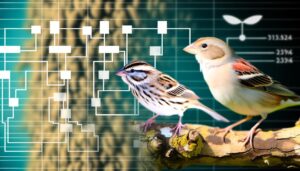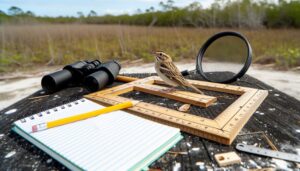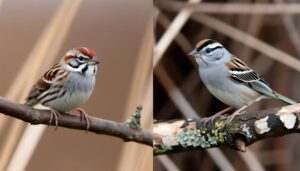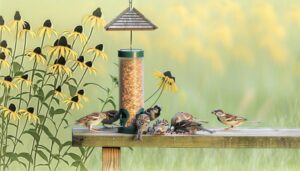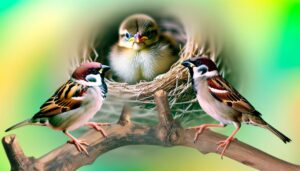10 Common Sparrows Found in Michigan
Michigan harbors several common sparrow species including the Song Sparrow, American Tree Sparrow, Chipping Sparrow, and Grasshopper Sparrow. Other familiar types are the Field Sparrow and White-throated Sparrow.
The well-known House Sparrow is particularly adaptable, thriving in human-altered environments. These splendid species all exhibit unique behaviors, songs, and identifiable characteristics that make them a remarkable part of Michigan's biodiversity.
For instance, the Chipping Sparrow is known for its vibrant crown and black eye-line. There's an abundance of fascinating detail to learn about the habits, traits, and conservation efforts of these Michigan sparrows.
Exploring further will surely reveal even more intriguing facts.

Key Takeaways
- Michigan is home to various sparrow species including the Song Sparrow, American Tree Sparrow, Chipping Sparrow, Grasshopper Sparrow, Field Sparrow, and White-throated Sparrow.
- Chipping Sparrows, identifiable by their bright crown and black eye-line, thrive in open woodlands and suburban backyards.
- The American Tree Sparrow migrates to Michigan in the winter and prefers open tundra and shrublands.
- Field Sparrows in Michigan are known for their adaptability to various habitats including fields, scrublands, and edges of forests.
- Conservation efforts for Michigan sparrows include habitat restoration, predator control, public education, legal protections against poaching, and a commitment to preserving biodiversity.
Understanding Sparrow Species
In the field of ornithology, it's critical to comprehend the diverse species of sparrows that grace Michigan's skies, each with its unique characteristics, behaviors, and habitats.
The Song Sparrow, for example, is renowned for its melodic trills and extensive vocal repertoire. It's primarily found in dense, shrubby environments.
The American Tree Sparrow, on the other hand, prefers open tundra and shrublands, distinguishing itself with its rusty cap and eyeline.
The Chipping Sparrow is identifiable by its bright, rusty crown and black eye-line; it's a common sight in open woodlands and suburban gardens.
Each species displays adaptive traits, enabling them to thrive in these specific habitats. Therefore, understanding these nuances provides valuable insights into their ecological roles and conservation needs.
The Ubiquitous House Sparrow
The House Sparrow, a common bird in Michigan, boasts distinct characteristics that aid in its identification.
Its dietary preferences and habitat requirements offer insight into its habits and roles within its ecosystem.
This species' omnipresence, while sometimes overlooked, plays a significant part in maintaining ecological balance.
House Sparrow Identification
Often spotted in urban areas throughout Michigan, house sparrows exhibit a distinctive color pattern that's relatively easy to identify. Males typically have a gray head, white cheeks, and a black bib, contrasting sharply with their ruddy-brown back and wings speckled with black.
Females and young ones, however, are more uniformly brown and gray, lacking the males' vibrant patterning. Their short, stout beaks are perfect for their diet, which will be discussed later. House sparrows also have a distinguishing feature in their constant, lively chirping.
Observing these traits will help in accurately identifying house sparrows in Michigan. While other species may share similar attributes, the combination of these specific characteristics makes the house sparrow unique among its feathered brethren.
Sparrow's Diet and Habitat
Diving into the world of their diet and habitat, house sparrows aren't picky eaters and thrive in a variety of environments, making them one of the most widespread bird species in Michigan. Their omnivorous diet consists primarily of seeds, grains, and insects, providing an essential balance in their ecosystem.
An observational study found that during colder months, they tend to favor high-energy foods like seeds and grains.
Regarding their habitat, house sparrows favor human-altered environments, such as farms, residential, and urban areas. They're incredibly adaptable, nesting in a wide array of places, from birdhouses and tree holes to building crevices.
Their adaptability to various habitats and robust diet makes them a resilient species in Michigan's diverse landscapes.
Importance in Ecosystem
Despite their humble appearance, house sparrows play a crucial role in the ecosystem, acting as both predator and prey within their food web. They're instrumental in controlling insect populations, particularly those that threaten agricultural crops. Their diet, composed primarily of seeds and insects, positions them as essential for seed dispersal, contributing significantly to plant biodiversity in their habitats.
While these birds are prey for larger predators like hawks and cats, their prolific reproductive nature ensures their population stability. Their nests provide shelter for other bird species, enhancing avian diversity. Their vocalizations, too, alert other creatures to potential dangers.
Therefore, the humble house sparrow, often overlooked, is indeed a crucial cog in Michigan's ecological machinery.
The Elusive Grasshopper Sparrow
Nesting in the tall grasses, the elusive Grasshopper Sparrow, so named for its insect-like melody, presents a captivating study in avian adaptation within Michigan's diverse habitats. This species thrives in open fields and meadows, often choosing to nest on the ground where it's easily overlooked by predators.
The Grasshopper Sparrow's unique characteristics set it apart from other sparrows in Michigan. To give you an idea, here's a quick comparison:
| Characteristic | Grasshopper Sparrow | Other Michigan Sparrows |
|---|---|---|
| Melody | Insect-like | Varies |
| Nesting Site | Ground | Varies |
| Environment | Open fields and meadows | Diverse |
Its insect-like melody, ground nesting behavior, and preference for open habitats render it a delight for birdwatchers and an essential part of Michigan's biodiversity. Understanding this elusive sparrow aids in maintaining the balance in our ecosystem.
Identifying the Song Sparrow
Shifting our focus from the Grasshopper Sparrow, we turn our attention to another prominent Michigan resident, the Song Sparrow, recognized for its melodious and complex song patterns. This species is relatively easy to identify due to certain distinguishing features.
Notable traits include:
- A heavily streaked chest with a central dark spot, resembling a stickpin
- Brown streaked upperparts with grayish face and underparts
- Long, rounded tail and robust beak
- A song that typically consists of several clear notes followed by a complex trill
Careful observation of these features can help birdwatchers differentiate the Song Sparrow from other sparrows. Its song, while variable, always has a distinct structure that reflects its name, making this bird a delightful presence in Michigan's diverse avifauna.
Exploring the Chipping Sparrow's Habitat
Diving into the world of the Chipping Sparrow, we find this species thriving in a variety of habitats across Michigan, from open woodlands to suburban backyards.
The Chipping Sparrow, scientifically known as Spizella passerina, exhibits a remarkable adaptability. It favors the edges of forests where the tree line meets open areas, providing ample opportunities for foraging and nesting.
It's also drawn to human-altered landscapes, including parks, gardens, and golf courses, where it can find food and nesting materials. The bird's diet consists mainly of seeds and insects, which are plentiful in these environments.
Observations indicate that the Chipping Sparrow's habitat preference may be influenced by its flexible diet and nesting habits, reflecting its successful adaptation to Michigan's diverse ecosystems.
American Tree Sparrow: Winter Visitor
The American Tree Sparrow is known for its reddish-brown cap and eyeline, contrasting with a gray face and underparts. Its bi-colored bill, yellow lower mandible, and dark upper mandible also distinguish it. During winter, this sparrow can be found in open fields, brushy areas, and at feeders, often foraging on the ground for seeds. It is a sociable bird, forming large flocks with other sparrows while migrating and wintering. These behaviors and physical attributes combine to create a fascinating bird to observe and study in Michigan during the winter months.
Identifying American Tree Sparrow
Sporting a distinctive reddish cap and a gray face, the American Tree Sparrow often graces Michigan's chilly winters with its presence, offering keen birdwatchers an exciting identification challenge. This sparrow's striking features aid in distinguishing it from other common sparrows.
The following key identifiers can guide enthusiasts in correctly spotting this feathered visitor:
- *Size and Shape*: Roughly the size of a robin, they possess a round head, long tail, and stout bill.
- *Color Pattern*: They exhibit a dark, conical bill, a prominent reddish crown, and a smudged, grayish breast.
- *Eye Line*: A thin, distinct eye line extends behind the eye, contrasting with the gray face.
- *Wing Bars*: Two white wing bars are visible on the brown, streaked wings.
Such details are essential in differentiating the American Tree Sparrow from other species.
Habitat and Behavior
With winter's arrival, American Tree Sparrows migrate to Michigan, favoring shrubby, open habitats and often spotted flitting about in weedy fields or along roadsides.
They're hardy birds, adapting well to the harsh conditions. Their diet primarily consists of seeds and berries, but they're known to eat insects when available. They forage on the ground, underneath shrubs or in low vegetation, utilizing a unique double-scratch method.
Social birds, they often form flocks with other sparrows, displaying a complex hierarchy within the group. At night, they roost in coniferous trees or thick shrubs to seek shelter from the cold.
Despite their name, these sparrows don't nest in trees, instead, they breed in the Arctic tundra during summer, returning to Michigan in winter.
Field Sparrow: Countryside Dweller
Embracing the tranquility of rural landscapes, Field Sparrows make their presence known through their distinct, bouncing ball song, adding a unique harmony to Michigan's countryside. These small, elegant birds, scientifically known as Spizella pusilla, are characterized by their pinkish beaks and legs, and the notable absence of striking patterns on their feathers, which allows them to blend in with their surroundings.
Their unique traits include:
- Adaptability to various habitats, from open fields to shrubby areas.
- Mainly insectivorous diet, supplementing with seeds in colder months.
- Notable, clear song, which is a rhythmic series of high notes.
- Breeding behavior characterized by the construction of ground nests.
In understanding the Field Sparrow, one gains a deeper appreciation of Michigan's rich avian diversity.
White-throated Sparrow: Forest Singer
Although less common in urban areas, the White-throated Sparrow, known scientifically as Zonotrichia albicollis, has carved out a niche for itself in Michigan's dense forests, enchanting hikers and birdwatchers with its melodious and distinctive song.
This songbird's distinct vocalization, often described as a sweet, high-pitched whistle, can be heard throughout the forest, making it a familiar sound in Michigan's wild landscapes. Its plumage is equally distinctive, with a bright white throat, yellow lores, and striking black-and-white stripes on its head.
The White-throated Sparrow's diet primarily consists of seeds, fruits, and insects, which it forages from the ground. Despite their apparent preference for forested habitats, these sparrows have also been observed in fields and roadsides, demonstrating their adaptability and resilience.
Conservation Efforts for Michigan Sparrows
In response to the changing habitats and threats facing Michigan's sparrow population, numerous conservation efforts are underway to protect these bird species. These initiatives aim to both sustain the existing population and encourage its growth. They're focused on ensuring survival of these feathered creatures, so important for maintaining the ecological balance.
Key methods of these conservation efforts include:
- Habitat Restoration: Restoring and preserving natural habitats to reduce the impact of urbanization.
- Predator Control: Implementing strategies to control the population of natural predators.
- Public Education: Raising public awareness about the importance of sparrows and their role in ecology.
- Legal Protections: Enforcing laws and regulations to prevent poaching and illegal trade.
These efforts underscore the commitment to preserving Michigan's biodiversity and maintaining its rich avian life.
Conclusion
In the heart of Michigan's landscapes, sparrows don their different coats, each a proof of their unique identities.
From the House Sparrow's urban dwellings to the Grasshopper Sparrow's disappearing grasslands, they sing their varied songs.
The Song, Chipping, and Field Sparrows serenade, while the American Tree and White-throated Sparrows brave Michigan's winter chill.
These common, yet fascinating creatures are the subject of tireless conservation efforts, reminding us of the delicate interplay between human progress and nature's resilience.

